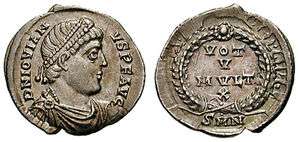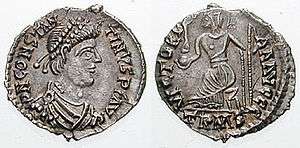Siliqua
The siliqua (plural siliquae) is the modern name given (without any ancient evidence to confirm the designation) to small, thin, Roman silver coins produced in the 4th century A.D. and later. When the coins were in circulation, the Latin word siliqua was a unit of weight defined by one late Roman writer as one twenty-fourth of the weight of a Roman solidus.[1]
"Siliqua vicesima quarta pars solidi est, ab arbore, cuius semen est, vocabulum tenens."
A siliqua is one-twentyfourth of a solidus [coin] and the name is taken from the seed of a tree.— Isidore of Seville, Etymologiarum libri XX, Liber XVI, 25


The term siliqua comes from the siliqua graeca, the seed of the carob tree, which in the Roman weight system is equivalent to 1/6 of a scruple (1/1728 of a Roman pound or about 0.19 grams).
The term has been applied in modern times to various silver coins on the premise that the coins were valued at 1/24 of the gold solidus (which weighed 1/72 of a Roman pound) and therefore represented a siliqua of gold in value. Since gold was worth about 14 times as much as silver in ancient Rome, such a silver coin would have a theoretical weight of 2.7 grams. There is little historical evidence to support this premise. This has not prevented the term from being applied today to silver coins issued by Constantine, which initially weighed 3.4 grams, or the later silver coin of Constantius II, which weighed about 2.2 grams and 18 mm, and is sometimes called a "light" or "reduced" siliqua to differentiate it. The term is one of convenience, as no name for these coins is indicated by contemporary sources. Thin silver coins as late as the 7th century which weigh about 2 to 3 grams are known as siliquae by numismatic convention.
The majority of examples suffer striking cracks (testimony to their fast production) or extensive clipping (removing silver from the edge of the coin), and thus to find both an untouched and undamaged example is fairly uncommon. It is thought that by clipping, siliquae provided the first coinage of the Saxons, as this reduced them to around the same size as a sceat, and there is considerable evidence from archaeological sites of this period, that siliquae and many other Roman coins were utilised by Saxons as pendants, lucky charms, currency and curiosities.
See also
- Roman currency
- Hoxne Hoard, a hoard of 14,212 silver siliquae dating from the early 5th century.
References and external links
| Wikimedia Commons has media related to Siliqua. |